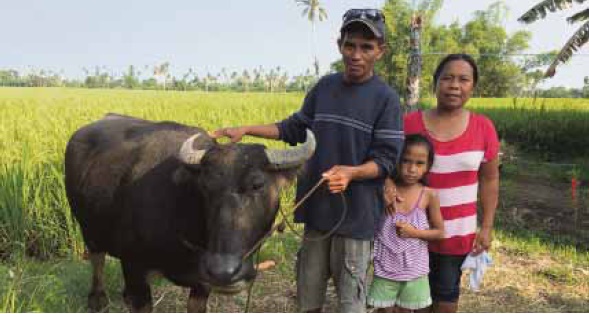
PLODDING ON Farmer Mario Mercado, wife Lucresia and daughter Joyce of Pastrana town, Leyte province, pose with their “faithful partner” Yolanda, the carabao given to them by an Army officer who also helped them rebuild their home after it was washed away by Supertyphoon “Yolanda” in 2013. JERRY ESPLANADA
PASTRANA, Leyte—In many towns and cities nationwide, dogs are considered man’s best friend.
But in Barangay Lima (population: about 600) in this fifth-class farming community, carabaos, or water buffalos, are met with the same affection, if not face stiff competition with dogs.
One of the carabaos is Yolanda, who for the past two years has been a “beloved and faithful partner” of farmer Mario Mercado.
Nearly 5 years old, she was named by Mercado’s wife Lucresia after Supertyphoon “Yolanda” (international name: Haiyan), which ravaged Eastern Visayas on Nov. 8, 2013.
It was the most powerful storm ever recorded to hit land, wiping out a number of coastal and inland communities and leaving over 7,300 people dead or missing.
Yolanda has been Mercado’s “constant companion” as he plows the family’s small rice field, relying on her draft power, hard work and patience to get the job done.
Soon, the carabao, who is 4 months pregnant, would be a source of milk for pastillas and other native sweets, as well as native dishes, the 44-year-old Waray native told the Inquirer.
The couple both speak of Yolanda not only something with an inherent value, but one who is “really special.”
Nearly two years after the typhoon devastated the impoverished area, which is part of Leyte province’s rice granary, the disaster still haunts the Mercados.
“Save for a few clothes and personal belongings, we lost almost all of our possessions, including our home,” recalled Mercado’s wife.
He said their woes had become a thing of the past. “I know in my heart that we’re all right now,” he said, noting their work animal was integral to their recovery.
Blessing in disguise
The typhoon has proven to be a blessing in disguise.
“There’s Yolanda, our carabao, who is living proof of that, as well as the fact there are still (Good Samaritans) in this day and age,” he said.
He said that a month after Supertyphoon Yolanda struck, a Manila-based Army officer who took part in the search-and-rescue operations initially offered financial assistance to help him rebuild his home in Lima, a 45-minute drive from Tacloban City.
“To our surprise, the same person sent us additional cash, allowing us to purchase Yolanda from one of our neighbors,” he said.
On top of that, the military official “has been sending some money for the school expenses of our daughter Joyce,” a Grade 3 pupil at Pastrana Central Elementary School, he said. Joyce, 8, has three siblings—brothers Jay, 17, James, 15 and Ejay, 12.
“We can’t thank (the officer) enough for adopting our family,” said Mercado. He asked that the name of the officer be withheld.
Prayers for the dead
On Nov. 8, the second anniversary of Yolanda’s onslaught, the couple plan to offer prayers for those who perished.
“We also plan to pray and thank the many charitable people and groups who helped those who survived the tragedy, like my family,” he said.
Unlike some farmers who sold their water buffalos and replaced them with small hand tractors, Mercado said he and his wife would continue to make their carabao play a significant role in their barrio’s farming system.
The government-run Philippine Carabao Center (PCC) said that in January 2015, there were about 2.86 million carabaos nationwide, with Leyte accounting for 117,419.
The PCC noted that “the carabao is a major contributor to the total agricultural economy of the country. Its main economic beneficiaries are the smallholder families, who own 99 percent of this important animal resource.”
P10-B production
“The volume of meat production from this subsector reached 140,034 metric tons in 2013, valued at P10.74 billion. On the other hand, milk production from carabao is estimated at 6.6 million liters, valued at P330 million. The largest contribution of the subsector was in terms of crop production yield, where carabaos provided significant draft power worth an estimated P8.16 billion,” it said.
However, “small hand tractors are increasingly replacing the carabao as a source of farm power, particularly in irrigated rice-producing areas. Given this development, the carabao is now being improved as a potential source of meat and milk,” the PCC added.
Barangay Captain Artemio Quitorio said that with Lima’s carabao head count at a very low 30, they would “do our part in pushing for carabao population growth.”